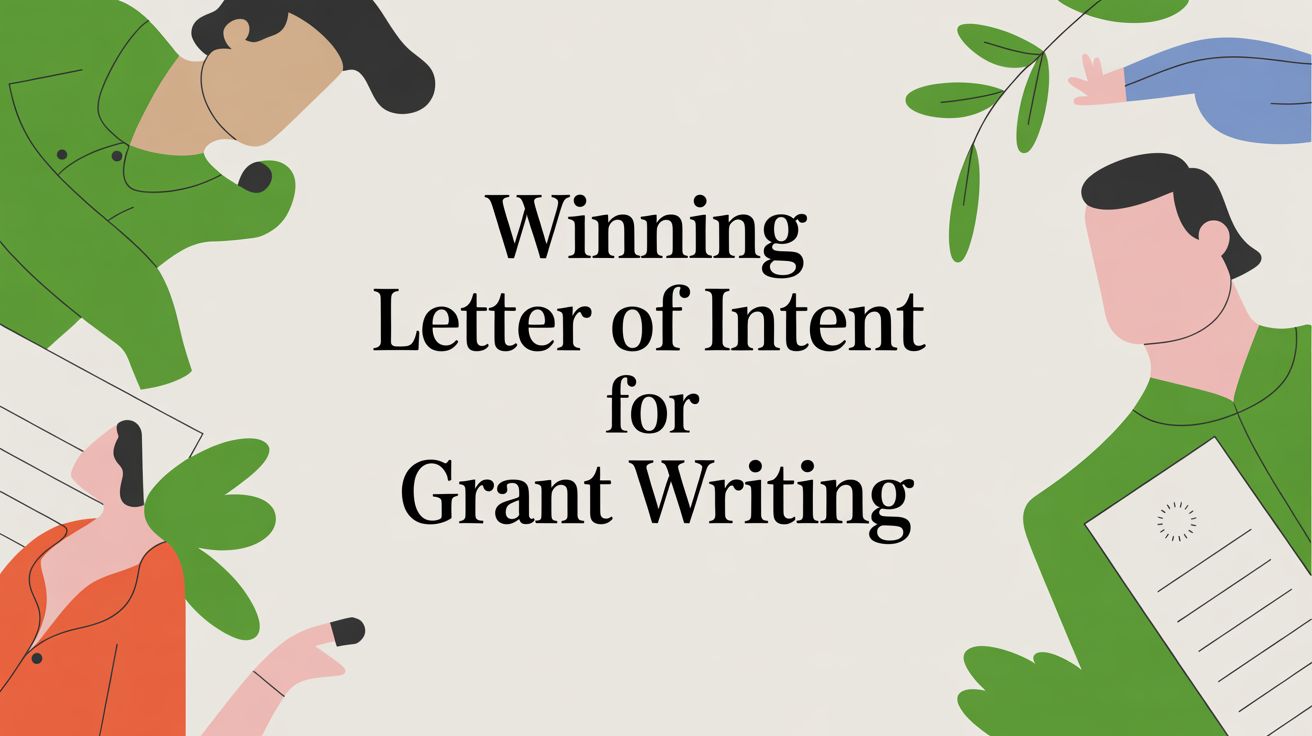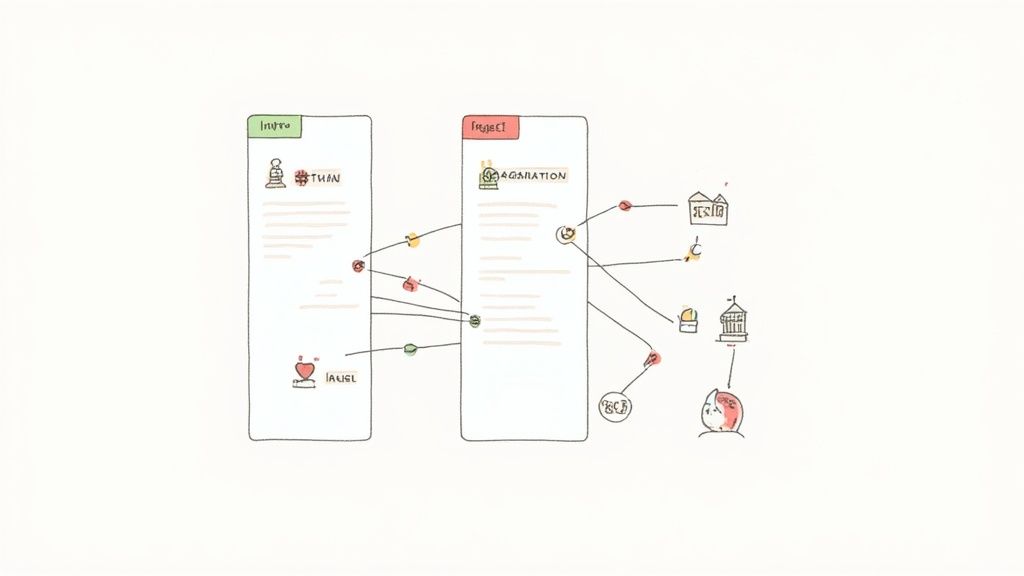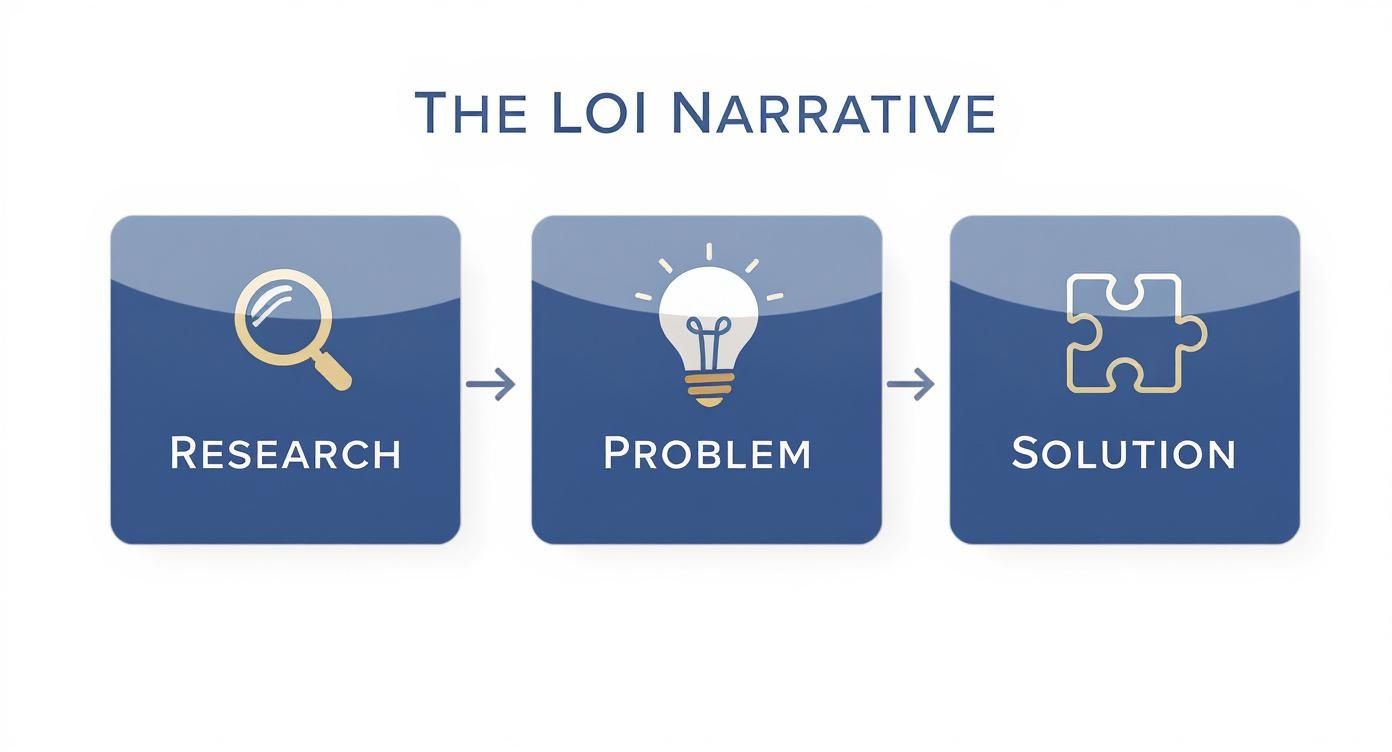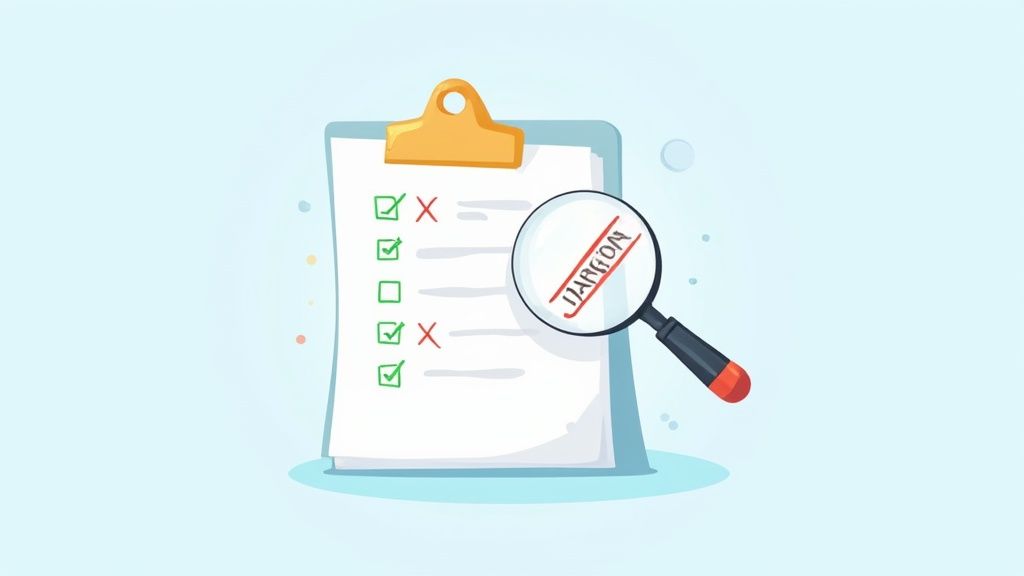Winning Letter of Intent for Grant Writing
Learn how to write a letter of intent for grant that gets noticed. Get practical tips, real-world examples, and expert advice to secure funding.

A letter of intent for a grant is a preliminary document you send to a funder before you dive into writing a full, detailed proposal. The best way to think of it is as a powerful, condensed preview. Its whole job is to quickly show a foundation that your project is a fantastic match for their mission, saving everyone a lot of time and effort down the road.
What a Letter of Intent for a Grant Really Is

Let's get one thing straight: a Letter of Intent (LOI) isn't just a hoop to jump through. It’s your first real handshake with a potential funder and your golden opportunity to make a lasting impression in a very crowded room.
Funders rely on LOIs as a crucial filtering tool. It allows their team to efficiently sift through hundreds, sometimes thousands, of inquiries to pinpoint the projects that truly resonate with their goals. A well-written one gets your foot in the door and puts you on the shortlist for serious consideration.
At its heart, the LOI is all about determining if your nonprofit and the funder are a good fit for each other. It's a smart, strategic step that helps both sides.
- For the Funder: It saves them countless hours. Their review committees avoid wading through lengthy proposals that were never going to be a good match in the first place.
- For Your Nonprofit: It saves your team from pouring 40-80 hours (or more!) into writing a full-blown proposal for a grant you have a slim chance of winning.
This pre-screening step is now the norm, not the exception. In fact, over 60% of grant providers now require an LOI as the first move. This is a direct result of the sheer volume of proposals they receive, which can easily climb into the tens of thousands for larger foundations.
To give you a clearer picture, here's a quick breakdown of what makes up an LOI.
Letter of Intent At a Glance
As you can see, every piece of the LOI serves a strategic purpose in making a compelling case—quickly.
Differentiating the LOI from the Full Proposal
It's absolutely critical to understand that a letter of intent is a completely different beast from a full proposal. They both advocate for your project, sure, but their scope and purpose are miles apart. The LOI is the highlight reel; the full proposal is the in-depth documentary. If you want to dig deeper into the specifics, you might find our guide on https://www.fundsprout.ai/resources/what-is-a-grant-proposal helpful for understanding the distinctions.
An LOI answers the question, "Should we learn more about this project?" A full grant proposal answers the question, "Should we fund this project?" Grasping this difference is the secret to writing an LOI that does its job: getting you invited to submit the full proposal.
The Strategic Value of a Strong First Impression
Beyond just being a screening tool, the LOI is your first real chance to build a relationship. It’s a reflection of your organization's professionalism, the clarity of your vision, and your overall competence.
A thoughtfully crafted letter shows that you've done your research, you respect the funder's time, and you have a solid, actionable plan. Think about it from their perspective: if your LOI is confusing, full of jargon, or completely misses the mark on their priorities, they'll assume your full proposal will be just as messy.
On the other hand, a concise, compelling, and perfectly aligned LOI signals that you are a serious, professional organization. It makes a reviewer want to see what you can do with a full application.
Breaking Down a Winning Grant LOI

Think of your letter of intent as a miniature story. It needs a clear beginning, middle, and end. Each section should flow logically into the next, building a persuasive narrative that takes the reviewer from a pressing problem straight to your brilliant solution.
While you should always follow a funder's specific guidelines, most effective LOIs share a common DNA. This structure isn't just a checklist; it's a strategic framework designed to make a reviewer feel confident in your organization’s vision and competence before they even think about inviting a full proposal. Let's walk through each essential piece.
The Introduction and Summary
Your opening paragraph is your handshake. It has to be firm, direct, and immediately establish who you are, what you need the money for, and exactly how much you're asking for. This is no time for a slow, meandering introduction. Get right to it.
For example, lead with a confident statement like: "The Youth Coders Initiative, a 501(c)(3) dedicated to closing the tech gap, respectfully requests $40,000 to launch our 'Code for Tomorrow' after-school program for 100 underserved high school students in Springfield." In one sentence, the funder knows your name, mission, project, target population, and the ask. Boom. Done.
The Statement of Need
This is the heart and soul of your letter. Your mission here is to move beyond dry statistics and paint a vivid, urgent picture of the problem you're solving. You want the reviewer to feel the "why" behind your work. Why does this issue matter, and why is now the time to act?
A weak statement of need is generic: "Many students in our city lack STEM skills." A powerful one connects that data to real, human consequences.
Pro Tip: Always frame the problem in a way that resonates with the funder’s specific mission. If you're writing to a foundation like the WT Grant Foundation, which focuses on reducing inequality, your statement should explicitly frame the problem through that lens. It's not just an educational gap; it's an issue of equity and access.
To build a truly compelling case, I always recommend weaving these elements together:
- Humanize the Data: Don't just throw numbers at them. Start with a statistic, then immediately follow it with a short, anonymized story that shows its real-world impact. You could mention that 65% of local jobs will require tech skills by 2030, then explain how this leaves students from low-income households at a severe disadvantage in their own community.
- Establish Urgency: Explain why this problem demands attention right now. Is there a new economic reality, a recent study, or a fleeting window of opportunity that makes your project incredibly timely?
- Show Your Community Connection: This isn’t a problem you’ve observed from afar. Show the funder you are deeply embedded in the community you serve and are uniquely positioned to address the challenge from the inside out.
The Project Description
Okay, you've laid out the problem. Now, here's your solution. This section is where you briefly explain what your project will actually do. Outline your main goals, the key activities you'll undertake, and the outcomes you expect to see. The trick is to be concise while still showing you've got a solid, well-thought-out plan.
Don't get bogged down in the day-to-day operational details. Stick to the big picture.
- Goals: What are the broad aims? (e.g., "To increase STEM proficiency and college readiness among participants.")
- Activities: What are the core actions you'll take? (e.g., "We will deliver 12 weeks of hands-on coding instruction, one-on-one mentorship from tech professionals, and college application workshops.")
- Outcomes: What measurable changes will result? (e.g., "80% of participants will demonstrate improved coding skills, and 50% will apply to a STEM-related college program.")
Drawing that clear line from activities to outcomes shows you’re laser-focused on impact, not just on being busy.
Organizational Background and Capacity
Now that the reviewer gets the problem and your solution, you have to prove you’re the right organization to pull it off. This is your credibility section. Briefly touch on your organization's history, mission, and—most importantly—your track record of success with similar work.
A specific, quantified achievement goes a long way here. For instance: "For the past five years, our literacy programs have helped over 500 children improve their reading levels by an average of two grades." That single sentence builds immense trust and shows you know how to deliver results.
The Budget Summary and Conclusion
Finally, it's time to land the plane. Reiterate the total project cost and the specific amount you are requesting from this funder. A detailed, line-item budget isn't necessary here; just provide the top-level numbers.
Your conclusion should be professional and polite. Thank the funder for their time and consideration, and clearly state what you hope the next step will be. Something like, "We would be delighted to submit a full proposal at your request and welcome the opportunity to discuss this project further," works perfectly. Sign off with your contact information, and that's it. You’ve just guided them through a powerful, persuasive case for support.
Crafting Your Narrative to Win Over Reviewers
Knowing the right pieces to include in a Letter of Intent is the start, but weaving them into a persuasive story is where the magic happens. This is the real craft of grant writing—turning a structured document into a compelling pitch that grabs a reviewer’s attention and makes them want to champion your cause. And honestly, this process begins long before you type a single word.
The foundation of any good grant narrative is solid, deep research. Before you even think about framing your project, you have to get inside the funder's world. Scour their website, yes, but also dig into their annual reports and look closely at the projects they've funded in the past. What specific words pop up again and again? Are they talking about "equity," "sustainability," or "community-led solutions"? Mirroring their language isn't about being phony; it’s about showing you speak their language and share their core values.
This initial intelligence gathering is what allows you to position your project as a natural, seamless extension of the work they already care about.
From Vague Problem to Urgent Need
Your problem statement—often called a needs statement—is where your story truly kicks off. It has to create a genuine sense of urgency. I see so many nonprofits make the mistake of being too broad here, and it just falls flat.
Let’s look at a quick before-and-after.
Before (Weak and Generic):
"Our community faces significant educational challenges. Many students are falling behind, and schools lack the resources to help them succeed after hours."
This is passive and completely forgettable. It doesn't tell the funder anything they don't already know or create any kind of emotional pull. Now, let’s bring it to life with data and focus.
After (Strong and Compelling):
"In Springfield’s North End, 45% of middle schoolers are reading below grade level, a statistic that has worsened by 10% since school closures in 2020. This isn't just a number; it represents a growing opportunity gap that disproportionately affects low-income families, placing a generation of students at risk of academic and economic precarity."
See the difference? This version is powerful. It names a specific place, uses a hard statistic, shows a negative trend, and frames the issue as an "opportunity gap"—a concept that really clicks with funders focused on equity.
Architecting a Clear and Convincing Solution
Once you’ve established a compelling "why," you have to present your solution with absolute clarity. A funder must be able to draw a straight, logical line from the problem you just described to the activities you’re proposing. This is where a lot of LOIs get muddy.
Your project description shouldn't be a laundry list of everything you might do. It needs to be a concise, strategic summary of your approach.
- Get Specific on the "How": Don’t just say, "We will provide tutoring services." Instead, try: "Our program will deliver twice-weekly, high-intensity reading interventions led by certified literacy specialists for 75 students." The details are what build credibility.
- Focus on Outcomes, Not Just Activities: A funder isn't just buying your time; they're investing in results. Articulate the measurable changes you expect to see. For example, "By the end of the school year, 70% of participating students will improve their reading comprehension scores by at least one grade level."
- Show Why You're the One: Briefly explain what makes your organization the right one for this work. Do you have a unique method, deep roots in the community, or a stellar track record? A single sentence can do the heavy lifting: "Our culturally-responsive curriculum, co-designed with community parents, has consistently outperformed standard interventions."
This kind of clarity is non-negotiable. It's shocking, but roughly 30% of grant applications fail simply because the initial LOI was too vague or lacked precise, measurable goals. With so many LOIs to read, funders don't have time to connect the dots for you.
A reviewer should finish reading your solution section and think, "That makes perfect sense. It's a logical, efficient, and promising way to tackle the problem they outlined."
Aligning Your Vision with Theirs
The final piece of the narrative puzzle is explicitly connecting your project to the funder's mission. You simply cannot assume they will make this connection on their own. You have to draw the line for them in bright, bold ink.
This goes way beyond just dropping their mission statement into your letter. It’s about showing a genuine, thoughtful alignment of purpose.
Weak Alignment:
"Our project fits your foundation’s goal of helping children."
Strong Alignment:
"Your foundation's strategic focus on 'uprooting the structural foundations of inequality' resonates deeply with our work. By closing the literacy gap for North End students, our 'Readers to Leaders' program directly addresses a key barrier to economic mobility and aligns with your commitment to creating equitable opportunities for all young people."
The second example proves you’ve not only read their mission but have actually understood its nuances. It uses their own language ("structural foundations of inequality") and shows exactly how your project serves as a tangible vehicle for achieving their bigger-picture goals. This final touch transforms your letter of intent for a grant from a simple request for money into a compelling invitation for a true partnership.
How to Tailor Your LOI for Different Funders
Sending a generic, one-size-fits-all letter of intent is probably the fastest way to get your proposal tossed. I’ve seen it happen time and time again. Every funder, whether it's a massive federal agency or a small family foundation, has its own unique language, priorities, and unwritten rules. Learning to tailor your pitch is what separates a forgettable request from one that actually starts a conversation.
The heart of your project won’t change, but how you frame it absolutely must. Think of it like a job interview—you wouldn't use the same exact pitch for a scrappy tech startup and a buttoned-up bank. The same logic applies here. Your job is to mirror the funder's worldview, showing them that your project isn't just a good idea, but the perfect fit for them.
Decoding Different Funder Types
First things first: you have to know who you're talking to. Each type of funder has a distinct personality and expects something different from a letter of intent for a grant.
- Federal Agencies: These guys are all about data, regulations, and scalability. Your LOI needs to be formal, precise, and packed with evidence. They want to see a clear, logical plan that sticks to their guidelines and shows the potential for broad, measurable impact.
- Private Foundations: Often driven by a founder's specific vision or a deep-seated mission, these funders respond to a powerful story. Data is still important, of course, but they're often more moved by the why behind your work. Your LOI should feel personal and deeply connected to their stated values.
- Community Foundations: Just like the name says, these organizations are laser-focused on local impact. Your letter must prove you have a deep understanding of the community you serve and show exactly how your project will benefit local residents. Highlighting local partnerships here is crucial.
- Corporate Funders: Corporations are on the lookout for partners who can boost their brand, engage their employees, and show a clear return on social investment. Your LOI should tie your project directly to their corporate social responsibility (CSR) goals, using business-like language that centers on outcomes and impact metrics.
This infographic breaks down the essential narrative flow that underpins any strong LOI. You’ll take this basic structure and adapt it for each funder type.

This visual shows that core progression: from deep research to identifying a problem and presenting a clear solution. These are the building blocks you'll customize for every funder you approach.
Funder Type vs LOI Focus
To really nail this, you need to speak the funder's language. A subtle shift in focus can make all the difference between getting an invitation to apply and getting a polite "no." This table breaks down how to adjust your angle based on who's reading your letter.
As you can see, the core project doesn't change—only the lens through which you present it. Making these strategic adjustments is non-negotiable for success.
Practical Examples of Tailoring
Let’s put this into practice. Imagine your nonprofit runs a financial literacy program for young adults. Here’s how you could frame that same project for two very different funders.
Scenario 1: The Community Foundation
For a local community foundation focused on youth empowerment, your pitch should be all about local stories and direct, tangible impact.
Example Pitch: "Our 'Money Smarts' program is a direct response to the 25% youth unemployment rate right here in our city. By equipping 150 local young adults with critical budgeting and savings skills, we are building a stronger, more resilient local workforce and empowering the next generation of Springfield's leaders."
Scenario 2: The Corporate Bank
Now, for a national bank with a CSR focus on economic mobility, you’d shift your language to reflect business outcomes and scalability.
Example Pitch: "The 'Money Smarts' curriculum provides a scalable solution to the national challenge of financial instability. Our program delivers measurable improvements in financial capability, aligning perfectly with your corporate commitment to fostering economic mobility and creating a pipeline of financially responsible future customers."
See the difference? The project is identical, but the framing is worlds apart. The first is about building up the local community; the second is about scalable impact and business alignment. Success hinges on your ability to make these kinds of strategic pivots.
Aligning with Corporate Social Responsibility
Corporate grant funding is a huge piece of the philanthropic puzzle, representing $21.09 billion in 2019 alone after a 13.4% jump from the prior year. These funders are increasingly using LOIs as a first-pass filter to find the best-aligned partners.
Corporations almost always demand strict adherence to LOI protocols. They are looking for projects with measurable social impact that also line up with their brand values and will resonate with their stakeholders.
Pro Tip: When you approach a corporation, always frame your project as a partnership. Show them how your work helps them achieve their CSR goals and tells a compelling story they can proudly share with their customers and employees.
By taking the time to research and customize your letter of intent for a grant, you elevate your request from a simple ask for money to the beginning of a genuine conversation. You’re showing the funder you understand their world and are ready to be a valuable, effective partner.
For more strategies on identifying the right funders in the first place, check out our guide on how to find grants for nonprofits.
Common Mistakes and Your Final Review Checklist

Before you hit 'send' on that letter, stop. Taking a moment for one last, careful review is probably the single most important thing you can do. This isn't just about catching a stray comma; it's your final chance to spot the strategic missteps that can get an otherwise great project tossed aside.
After spending hours, or even days, getting the story just right, you're too close to it. A fresh pair of eyes and a solid checklist are your best friends at this stage. Even seasoned grant writers fall into the same old traps when they've been staring at the same document for too long.
Sidestepping the Classic Blunders
Often, the line between a rejection letter and an invitation to submit a full proposal is razor-thin. It usually comes down to avoiding a few common, and almost always preventable, mistakes.
1. Ignoring Funder Directions
This is the cardinal sin of grant seeking, and it happens more than you'd think. If the funder asks for a two-page LOI with a 12-point font and one-inch margins, don't send them a three-page letter in a 10-point font. It’s an immediate signal that you either can't or won't follow simple instructions—a huge red flag for a potential partner.
2. Drowning in Jargon
You live and breathe your work, but the person reading your letter doesn't. You have to resist the urge to use technical acronyms and insider language that will just confuse them. Your goal is to be clear and compelling, not to prove you know a bunch of fancy terms.
A Quick Story From the Field: An environmental nonprofit once wrote about their project for "riparian zone restoration through benthic macroinvertebrate repopulation." The program officer, a generalist, had to Google it. A simple switch to "bringing riverbanks back to life by reintroducing vital aquatic insects" would have been instantly understood and far more powerful.
3. The "Me, Me, Me" Focus
Yes, your organization is doing amazing work. But the LOI isn't really about you. It's about the problem you're solving for the community. Letters that spend paragraph after paragraph on the organization's long history instead of the urgent need you're addressing just feel self-serving.
Your Pre-Submission Review Checklist
Think of this as your final pre-flight inspection. Go through it point by point. Better yet, have a colleague who hasn't read the letter a dozen times go through it with you. An objective opinion is pure gold right now.
Alignment and Funder Focus
- Does the very first paragraph get straight to the point: who we are, what we need, and how much we're asking for?
- Did we echo some of the funder's own language (e.g., "reducing inequality," "community-led solutions") from their mission statement?
- Is the link between our project and their priorities spelled out clearly, not just hinted at?
- Does this read more like a partnership proposal than a simple plea for cash?
Clarity and Impact
- Is our problem statement urgent, specific, and backed up with a powerful number or two?
- Could your neighbor read this and understand exactly what you do and why it matters?
- Are the outcomes we're promising actually measurable? (e.g., "75 students will improve reading scores by one grade level," not "students will get help").
- Have we been ruthless in cutting every single unnecessary word and acronym?
Professionalism and Polish
- Have at least two different people proofread this for typos and grammar? Seriously.
- Are the funder’s name, the contact person's name, and their title all spelled 100% correctly? You'd be shocked how many letters fail this simple test.
- Is the formatting clean and easy on the eyes? Is there enough white space to let it breathe?
- Did we follow every single submission rule—page count, font, file type—to the letter?
When you methodically work through these points, you're doing more than just proofreading. You're strategically making sure your letter of intent for a grant isn't just correct, but compelling, clear, and perfectly positioned for a "yes."
Answering Your Lingering LOI Questions
Even with a solid plan, a few nagging questions always seem to surface right when you're ready to write. Getting the small details right can make a huge difference in how professionally your project comes across. Let's clear up some of the most common sticking points so you can move forward with confidence.
How Long Should a Letter of Intent Be?
If the funder hasn't given you a specific page count, the golden rule is to keep it to a one to two-page maximum. A grant letter of intent is supposed to be a snapshot, a quick and compelling preview of your project. Sending a long, rambling letter undermines that entire purpose. It tells the funder you might struggle to be concise in the full proposal, which is a major red flag.
Think brevity and impact. Every single sentence needs to justify its existence on that page. If you can make your case powerfully in a single page, that's often your best bet.
Should I Contact the Program Officer First?
Yes, absolutely. If you can, do it. Connecting with a program officer before you even start writing is one of the smartest moves you can make. A quick, polite phone call or a well-crafted email can give you crucial insights you'll never find in the official guidelines.
A brief conversation can help you:
- Confirm You're a Good Fit: Quickly pitch your project and ask if it aligns with their current funding priorities.
- Get Your Questions Answered: You can ask about things they might not publish, like their preferred budget range or the specific outcomes they're most excited about.
- Start Building a Relationship: That first contact transforms you from a name on a piece of paper into a real person with a mission they can connect with.
A simple question like, "We're developing a project to tackle X by doing Y. Does that sound like it might fit with what you're looking for this cycle?" can save you an incredible amount of time and effort.
What if the Funder Has No Public Guidelines?
It’s definitely a bit nerve-wracking when a foundation accepts LOIs but gives you zero instructions. This is where you have to put on your detective hat.
When there are no formal rules, your best strategy is to look at their past funding decisions. Scour their website for lists of recent grantees. What kinds of projects did they fund? What do those organizations have in common? Are they all local? Do they focus on a specific demographic?
Use that information to essentially reverse-engineer their priorities. Then, craft your LOI to reflect the language, scope, and focus of the projects they've already supported. This makes your letter feel instantly familiar and aligned with their mission, even when you're flying blind.
Stop wasting time on mismatched grants and tedious proposal writing. Fundsprout uses AI to find your perfect funding matches and helps you write winning applications faster. See how Fundsprout can accelerate your funding journey.
Try 14 days free
Get started with Fundsprout so you can focus on what really matters.
